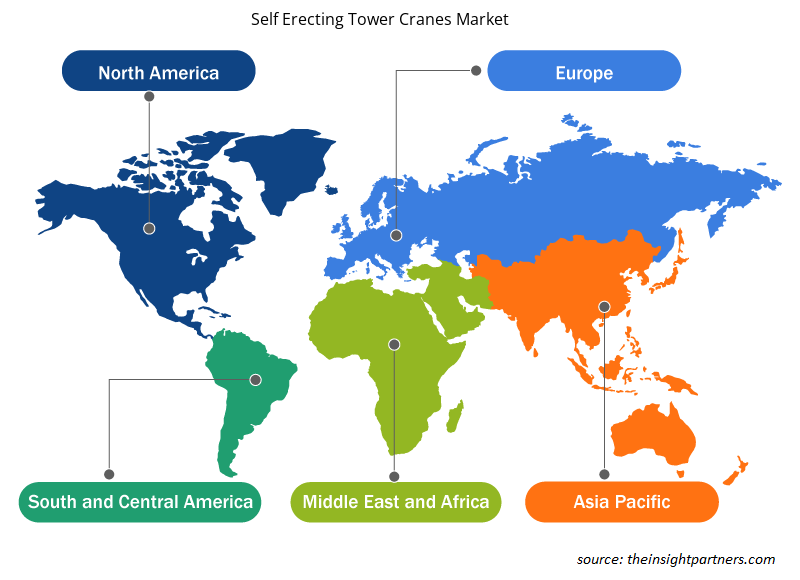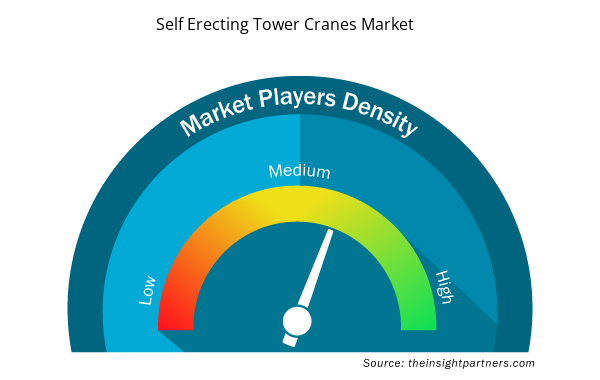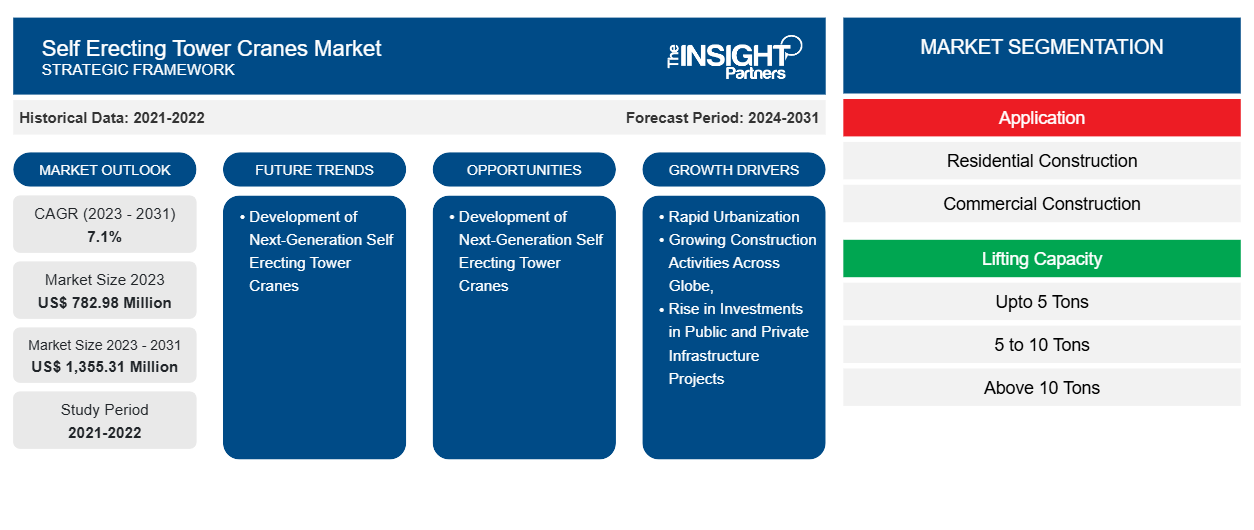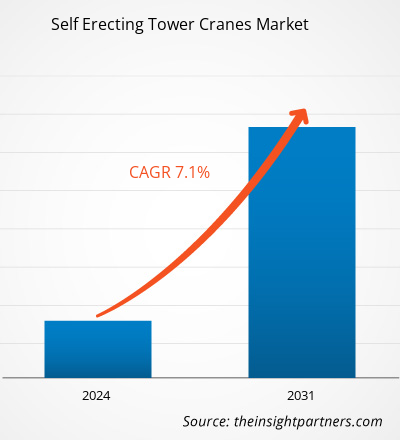Si prevede che il mercato delle gru a torre automontanti crescerà da 782,98 milioni di dollari USA nel 2023 e dovrebbe raggiungere 1.355,31 milioni di dollari USA entro il 2031. Si prevede che il mercato registrerà un CAGR del 7,1% nel periodo 2023-2031.
I principali attori del mercato delle gru a torre automontanti stanno sviluppando e adottando tecnologie avanzate per soddisfare le esigenze dei clienti nei cantieri edili. Le aziende stanno abilitando soluzioni telematiche per offrire flessibilità agli utenti in luoghi remoti. A gennaio 2024, il produttore di gru a torre Potain ha lanciato nuovissime tecnologie avanzate basate sul modello di gru automontante Evy 30-23 con una capacità di 4 tonnellate. La gamma di gru automontanti è progettata con il processo di sviluppo Voice of the Customer. Inoltre, l'azienda afferma che la nuova gamma è conforme allo standard di sicurezza europeo EN 14439 per le gru a torre.
Analisi di mercato delle gru a torre automontanti
Il settore delle costruzioni in Asia sta crescendo a un tasso di crescita notevole. Secondo l'Asia Development Bank Organization, i paesi dell'Asia Pacifica investono circa 1,7 trilioni di dollari all'anno nel settore delle costruzioni. Il settore sta crescendo a un ritmo rapido a causa della crescente domanda di progetti di costruzione residenziale e dei rapidi sviluppi infrastrutturali nel settore pubblico. A causa di tali sviluppi, la domanda di gru a torre automontanti sta aumentando a un ritmo notevole.
Panoramica del mercato delle gru a torre automontanti
Le gru a torre automontanti funzionano da remoto senza cabina. Le gru sono comunemente utilizzate in progetti di costruzione di piccole e medie dimensioni grazie alla loro natura autonoma e alla mancanza della necessità di gru aggiuntive. Uno dei fattori principali alla base della crescente domanda di gru a torre automontanti è la crescente urbanizzazione e l'aumento delle attività di costruzione. L'urbanizzazione comporta la conversione di terreni per uso residenziale, commerciale, industriale e di trasporto. Secondo l'elenco aggiornato delle aree urbane fornito dall'United States Census Bureau a dicembre 2022, la popolazione urbana negli Stati Uniti è aumentata del 6,9% tra il 2010 e il 2023. La regione occidentale degli Stati Uniti è rimasta la più urbana delle quattro aree censuarie del paese, con l'88,9% dei suoi abitanti che vive in città, seguita dalla regione nord-orientale con l'84,0% a partire dal 2022. Oltre agli Stati Uniti, anche la Spagna ha assistito a un notevole aumento dell'urbanizzazione.
Personalizza questo report in base alle tue esigenze
Riceverai la personalizzazione gratuita di qualsiasi report, comprese parti di questo report, o analisi a livello nazionale, pacchetto dati Excel, oltre a usufruire di grandi offerte e sconti per start-up e università
- Scopri le principali tendenze di mercato in questo rapporto.Questo campione GRATUITO includerà analisi di dati che spaziano dalle tendenze di mercato alle stime e alle previsioni.
Gru a torre automontanti: fattori trainanti e opportunità di mercato
Aumento degli investimenti in progetti infrastrutturali pubblici e privati
Nelle aree urbane e rurali, si registrano maggiori investimenti da parte dei governi di diversi paesi in attività di costruzione. Secondo il rapporto dell'Organizzazione della Banca Mondiale, nel 2022 sono stati investiti 91,7 miliardi di dollari in 263 progetti infrastrutturali nel settore privato in tutti i paesi a basso e medio reddito come India, Cina, Giappone e Africa. Ciò rappresenta una crescita del 23% nel 2022 rispetto al 2021, con un tasso di crescita medio del 4% nel periodo 2017-2021. Nel 2022, si è verificata una significativa ripresa delle attività di costruzione nei paesi in via di sviluppo con crescenti impegni di investimento dopo la pandemia di COVID-19.
Crescente numero di iniziative per le città intelligenti
I progetti di smart city si concentrano sulla transizione verso un'infrastruttura di servizi più efficiente ed efficace. I progetti di sviluppo di smart city utilizzano gru a torre, gru automontanti e altre attrezzature edili avanzate per ottimizzare la movimentazione dei materiali. L'uso di gru automontanti aiuta ad aumentare l'efficienza operativa, riduce l'uso di energia e le spese e porta a un processo decisionale proattivo. Secondo Smart America, a giugno 2022, i governi delle città negli Stati Uniti hanno annunciato il loro piano di investire circa 41 trilioni di dollari negli aggiornamenti delle infrastrutture e nell'implementazione di soluzioni Internet of Things nei prossimi 20 anni. Inoltre, l'obiettivo Horizon Europe della Commissione dell'Unione Europea mira a trasformare 100 città in città intelligenti e a impatto climatico zero entro il 2030.
Analisi della segmentazione del rapporto di mercato delle gru a torre automontanti
I segmenti chiave che hanno contribuito alla derivazione dell'analisi di mercato delle gru a torre automontanti sono l'applicazione e la capacità.
- In base all'applicazione, il mercato delle gru a torre automontanti è segmentato in edilizia residenziale, edilizia commerciale e altri. Il segmento residenziale ha detenuto la quota di mercato maggiore nel 2023.
- In base alla capacità di sollevamento, il mercato è suddiviso in modelli fino a 5 tonnellate, modelli da 5 a 10 tonnellate e modelli superiori a 10 tonnellate.
Analisi della quota di mercato delle gru a torre automontanti per area geografica
L'ambito geografico del rapporto sul mercato delle gru a torre automontanti è suddiviso principalmente in cinque regioni: Nord America, Asia Pacifico, Europa, Medio Oriente e Africa e Sud America.
L'Europa ha registrato la quota di mercato più grande per le gru automontanti nel 2023, a causa di un aumento della domanda di costruzione di piccole case residenziali e di un'impennata delle attività di costruzione di ponti, carreggiate e autostrade. La Germania ha il più grande mercato delle costruzioni, registrando un fatturato di 175 miliardi di dollari nel 2020, secondo i dati forniti da Germany Trade and Invest (GTAI). Inoltre, le iniziative del governo tedesco verso l'edilizia residenziale aumentano la domanda di gru automontanti nel paese. Nel 2024, il governo tedesco si è prefissato l'obiettivo di costruire 400.000 appartamenti all'anno. Oltre all'edilizia residenziale, gli investimenti nello sviluppo delle infrastrutture rafforzano la crescita del mercato delle gru automontanti.
Gru a torre automontanti: novità di mercato e sviluppi recenti
Il mercato delle gru a torre automontanti viene valutato raccogliendo dati qualitativi e quantitativi dopo la ricerca primaria e secondaria, che include importanti pubblicazioni aziendali, dati associativi e database. Di seguito è riportato un elenco di sviluppi e strategie nel mercato delle gru a torre automontanti:
- Terex Self Erecting Cranes ha annunciato la nomina di Kranlyft UK come distributore autorizzato per il Regno Unito e l'Irlanda. Con effetto immediato, Kranlyft UK offrirà la gamma completa di Terex Self-Erecting Cranes, tra cui la nuovissima gamma CSE e l'esclusiva FC 6.24, l'unica gru a rotazione superiore automontante in Europa, insieme a supporto per vendite, assistenza e ricambi. (Fonte: Terex Corp., Comunicato stampa/Sito Web aziendale/Newsletter, 2023)
- Il marchio leader di gru a torre Potain ha annunciato una nuovissima gru automontante, la Evy 30-23 4 t. Questo nuovo modello segna il debutto della gamma Evy, l'ultima generazione di gru automontanti Potain, progettata utilizzando il processo di sviluppo del prodotto Voice of the Customer e le richieste del mercato per semplicità e maggiore altezza sotto il gancio, oltre a essere conforme alla norma di sicurezza europea aggiornata EN 14439 per le gru a torre. (Fonte: Potain Group, comunicato stampa/sito Web aziendale/newsletter, 2023)
Approfondimenti regionali sul mercato delle gru a torre automontanti
Le tendenze regionali e i fattori che influenzano il mercato delle gru a torre automontanti durante il periodo di previsione sono stati ampiamente spiegati dagli analisti di Insight Partners. Questa sezione discute anche i segmenti di mercato delle gru a torre automontanti e la geografia in Nord America, Europa, Asia Pacifico, Medio Oriente e Africa e Sud e Centro America.

- Ottieni i dati specifici regionali per il mercato delle gru a torre automontanti
Ambito del rapporto di mercato sulle gru a torre automontanti
| Attributo del report | Dettagli |
|---|---|
| Dimensioni del mercato nel 2023 | 782,98 milioni di dollari USA |
| Dimensioni del mercato entro il 2031 | 1.355,31 milioni di dollari USA |
| CAGR globale (2023-2031) | 7,1% |
| Dati storici | 2021-2022 |
| Periodo di previsione | 2024-2031 |
| Segmenti coperti | Per applicazione
|
| Regioni e Paesi coperti | America del Nord
|
| Leader di mercato e profili aziendali chiave |
|
Densità degli attori del mercato delle gru a torre automontanti: comprendere il suo impatto sulle dinamiche aziendali
Il mercato delle gru a torre automontanti sta crescendo rapidamente, spinto dalla crescente domanda degli utenti finali dovuta a fattori quali l'evoluzione delle preferenze dei consumatori, i progressi tecnologici e una maggiore consapevolezza dei vantaggi del prodotto. Con l'aumento della domanda, le aziende stanno ampliando le loro offerte, innovando per soddisfare le esigenze dei consumatori e capitalizzando sulle tendenze emergenti, il che alimenta ulteriormente la crescita del mercato.
La densità degli operatori di mercato si riferisce alla distribuzione di aziende o società che operano in un particolare mercato o settore. Indica quanti concorrenti (operatori di mercato) sono presenti in un dato spazio di mercato in relazione alle sue dimensioni o al valore di mercato totale.
Le principali aziende che operano nel mercato delle gru a torre automontanti sono:
- Liebherr International AG
- La Manitowoc Co Inc.
- Terex Corp
- FMGru srl
- Grúas Sáez
- Italiano:
Disclaimer : le aziende elencate sopra non sono classificate secondo un ordine particolare.

- Ottieni una panoramica dei principali attori del mercato delle gru a torre automontanti
Copertura e risultati del rapporto di mercato sulle gru a torre automontanti
Il rapporto "Dimensioni e previsioni del mercato delle gru a torre automontanti (2023-2031)" fornisce un'analisi dettagliata del mercato che copre le seguenti aree:
- Dimensioni e previsioni del mercato a livello globale, regionale e nazionale per tutti i segmenti di mercato chiave coperti dall'ambito
- Dinamiche di mercato come fattori trainanti, vincoli e opportunità chiave
- Principali tendenze future
- Analisi PEST e SWOT dettagliate
- Analisi di mercato globale e regionale che copre le principali tendenze di mercato, i principali attori, le normative e gli sviluppi recenti del mercato
- Analisi del panorama industriale e della concorrenza che copre la concentrazione del mercato, l'analisi della mappa di calore, i principali attori e gli sviluppi recenti
- Profili aziendali dettagliati
- Analisi storica (2 anni), anno base, previsione (7 anni) con CAGR
- Analisi PEST e SWOT
- Valore/volume delle dimensioni del mercato - Globale, regionale, nazionale
- Industria e panorama competitivo
- Set di dati Excel



Report Coverage
Revenue forecast, Company Analysis, Industry landscape, Growth factors, and Trends

Segment Covered
This text is related
to segments covered.

Regional Scope
North America, Europe, Asia Pacific, Middle East & Africa, South & Central America

Country Scope
This text is related
to country scope.
Domande frequenti
Urbanization results in the conversion of land for residential, commercial, industrial, and transportation use. According to the updated list of urban areas provided by the United States Census Bureau in December 2022, urban population in the US increased by 6.9% between 2010 and 2023. The West region of the US remained the most urban of the country's four census areas, with 88.9% of its inhabitants living in cities, followed by the Northeast region with 84.0% as of 2022. Apart from the US, Spain has also witnessed a notable rise in urbanization. According to United Nations in 2023, 82.0% of the population lived in cities. With a rapidly increasing urban population, the construction sector is growing at a rapid pace. Small-scale construction activities are upsurging across the world. The self-erecting cranes play a vital role in fulfilling the demands for housing, lighting issues resolution, residential construction activities, and others.
Smart city projects focus on the transition to a more efficient and effective utility infrastructure. Smart city development projects use tower cranes, self-erecting cranes, and other advanced construction equipment to optimize material handling. The use of self-erecting cranes helps increase operational efficiency, reduces energy usage and expenditures, and leads to proactive decision-making. According to Smart America, in June 2022, city governments in the US announced their plan to invest ∼US$ 41 trillion in infrastructure upgrades and the implementation of Internet of Things solutions over the next 20 years. Also, the European Union Commission's Horizon Europe objective aims to transform 100 cities into climate-neutral and smart by 2030.
Key players in the self-erecting cranes market are developing and adopting advanced technologies to meet the customer's requirements at construction sites. Companies are enabling telematic solutions to offer flexibility for users at remote locations. In January 2024, the Potain tower crane manufacturer launched brand-new advanced technologies based on the Evy 30-23 self-erecting crane model with a capacity of 4 tons. The range of self-erecting cranes is designed with the Voice of the Customer development process.
Liebherr International AG, The Manitowoc Co Inc., Terex Corp., FMGRU SRL, Gruaz Saez S.L, Tavol Cranes Group, and ACE. are the key market players operating in the global self erecting tower crane market.
Trends and growth analysis reports related to Manufacturing and Construction : READ MORE..
The List of Companies - Self Erecting Tower Cranes Market
- Liebherr International AG
- The Manitowoc Co Inc.
- Terex Corp.
- FMGru srl
- Gruas Saez S.L
- Gru Dalbe srl
- Tavol Cranes Group Co.,ltd
- Dawson Group Ltd.
- P&J Acromet
- Action Construction Equipment Limited
The Insight Partners performs research in 4 major stages: Data Collection & Secondary Research, Primary Research, Data Analysis and Data Triangulation & Final Review.
- Data Collection and Secondary Research:
As a market research and consulting firm operating from a decade, we have published and advised several client across the globe. First step for any study will start with an assessment of currently available data and insights from existing reports. Further, historical and current market information is collected from Investor Presentations, Annual Reports, SEC Filings, etc., and other information related to company’s performance and market positioning are gathered from Paid Databases (Factiva, Hoovers, and Reuters) and various other publications available in public domain.
Several associations trade associates, technical forums, institutes, societies and organization are accessed to gain technical as well as market related insights through their publications such as research papers, blogs and press releases related to the studies are referred to get cues about the market. Further, white papers, journals, magazines, and other news articles published in last 3 years are scrutinized and analyzed to understand the current market trends.
- Primary Research:
The primarily interview analysis comprise of data obtained from industry participants interview and answers to survey questions gathered by in-house primary team.
For primary research, interviews are conducted with industry experts/CEOs/Marketing Managers/VPs/Subject Matter Experts from both demand and supply side to get a 360-degree view of the market. The primary team conducts several interviews based on the complexity of the markets to understand the various market trends and dynamics which makes research more credible and precise.
A typical research interview fulfils the following functions:
- Provides first-hand information on the market size, market trends, growth trends, competitive landscape, and outlook
- Validates and strengthens in-house secondary research findings
- Develops the analysis team’s expertise and market understanding
Primary research involves email interactions and telephone interviews for each market, category, segment, and sub-segment across geographies. The participants who typically take part in such a process include, but are not limited to:
- Industry participants: VPs, business development managers, market intelligence managers and national sales managers
- Outside experts: Valuation experts, research analysts and key opinion leaders specializing in the electronics and semiconductor industry.
Below is the breakup of our primary respondents by company, designation, and region:

Once we receive the confirmation from primary research sources or primary respondents, we finalize the base year market estimation and forecast the data as per the macroeconomic and microeconomic factors assessed during data collection.
- Data Analysis:
Once data is validated through both secondary as well as primary respondents, we finalize the market estimations by hypothesis formulation and factor analysis at regional and country level.
- Macro-Economic Factor Analysis:
We analyse macroeconomic indicators such the gross domestic product (GDP), increase in the demand for goods and services across industries, technological advancement, regional economic growth, governmental policies, the influence of COVID-19, PEST analysis, and other aspects. This analysis aids in setting benchmarks for various nations/regions and approximating market splits. Additionally, the general trend of the aforementioned components aid in determining the market's development possibilities.
- Country Level Data:
Various factors that are especially aligned to the country are taken into account to determine the market size for a certain area and country, including the presence of vendors, such as headquarters and offices, the country's GDP, demand patterns, and industry growth. To comprehend the market dynamics for the nation, a number of growth variables, inhibitors, application areas, and current market trends are researched. The aforementioned elements aid in determining the country's overall market's growth potential.
- Company Profile:
The “Table of Contents” is formulated by listing and analyzing more than 25 - 30 companies operating in the market ecosystem across geographies. However, we profile only 10 companies as a standard practice in our syndicate reports. These 10 companies comprise leading, emerging, and regional players. Nonetheless, our analysis is not restricted to the 10 listed companies, we also analyze other companies present in the market to develop a holistic view and understand the prevailing trends. The “Company Profiles” section in the report covers key facts, business description, products & services, financial information, SWOT analysis, and key developments. The financial information presented is extracted from the annual reports and official documents of the publicly listed companies. Upon collecting the information for the sections of respective companies, we verify them via various primary sources and then compile the data in respective company profiles. The company level information helps us in deriving the base number as well as in forecasting the market size.
- Developing Base Number:
Aggregation of sales statistics (2020-2022) and macro-economic factor, and other secondary and primary research insights are utilized to arrive at base number and related market shares for 2022. The data gaps are identified in this step and relevant market data is analyzed, collected from paid primary interviews or databases. On finalizing the base year market size, forecasts are developed on the basis of macro-economic, industry and market growth factors and company level analysis.
- Data Triangulation and Final Review:
The market findings and base year market size calculations are validated from supply as well as demand side. Demand side validations are based on macro-economic factor analysis and benchmarks for respective regions and countries. In case of supply side validations, revenues of major companies are estimated (in case not available) based on industry benchmark, approximate number of employees, product portfolio, and primary interviews revenues are gathered. Further revenue from target product/service segment is assessed to avoid overshooting of market statistics. In case of heavy deviations between supply and demand side values, all thes steps are repeated to achieve synchronization.
We follow an iterative model, wherein we share our research findings with Subject Matter Experts (SME’s) and Key Opinion Leaders (KOLs) until consensus view of the market is not formulated – this model negates any drastic deviation in the opinions of experts. Only validated and universally acceptable research findings are quoted in our reports.
We have important check points that we use to validate our research findings – which we call – data triangulation, where we validate the information, we generate from secondary sources with primary interviews and then we re-validate with our internal data bases and Subject matter experts. This comprehensive model enables us to deliver high quality, reliable data in shortest possible time.


 Ottieni un campione gratuito per questo repot
Ottieni un campione gratuito per questo repot